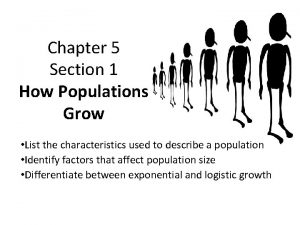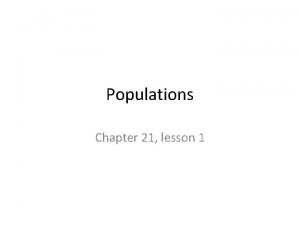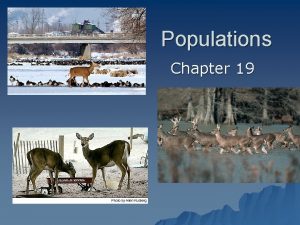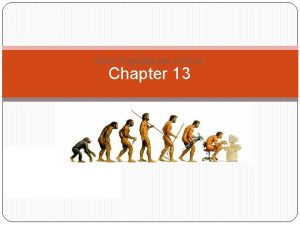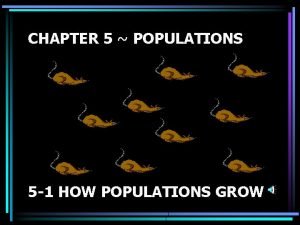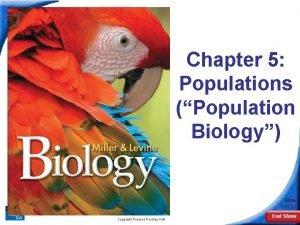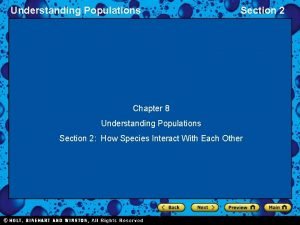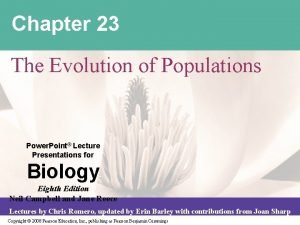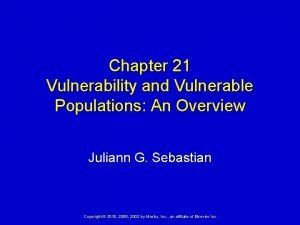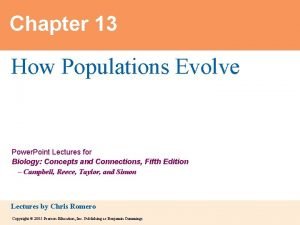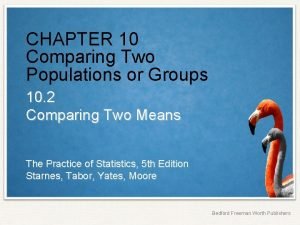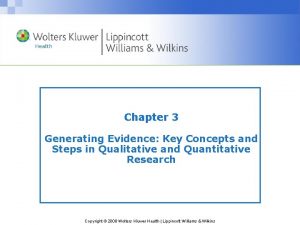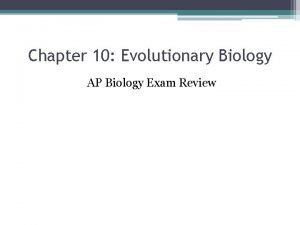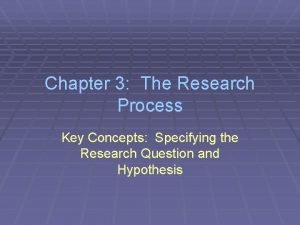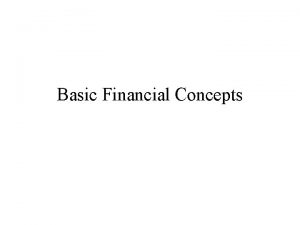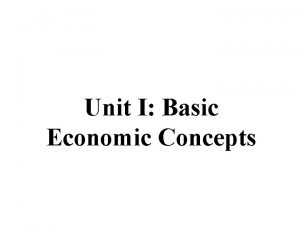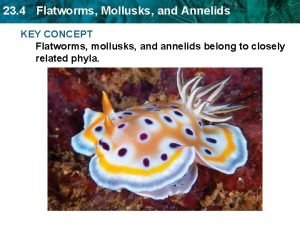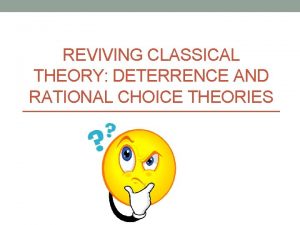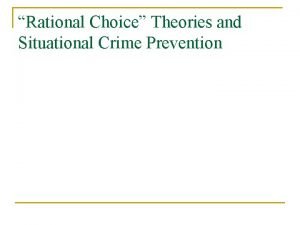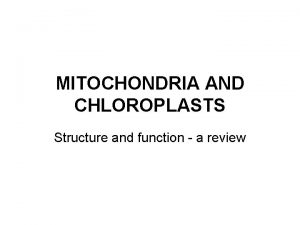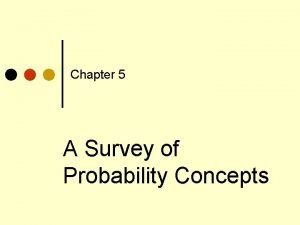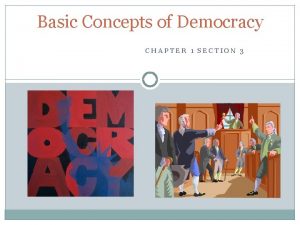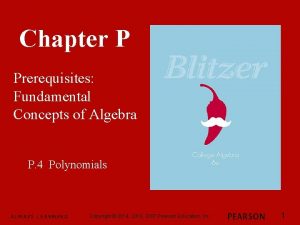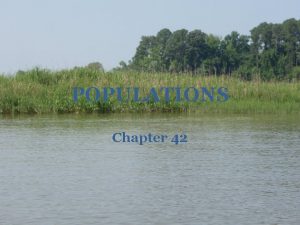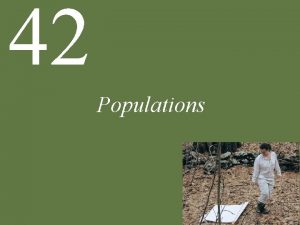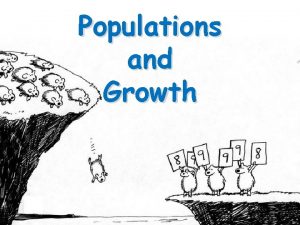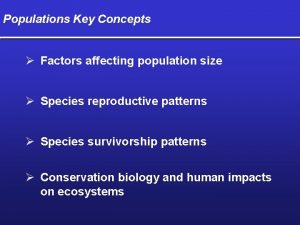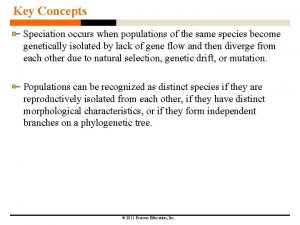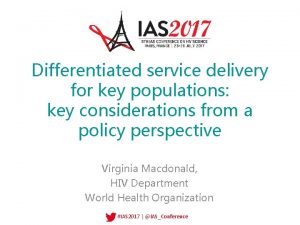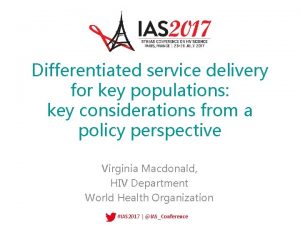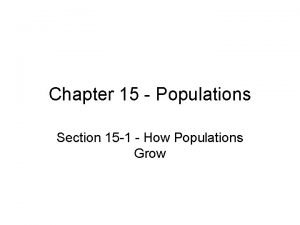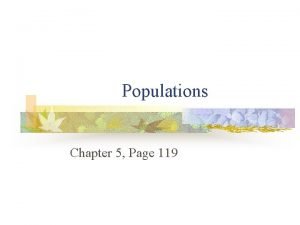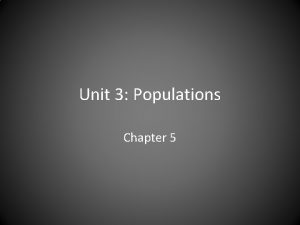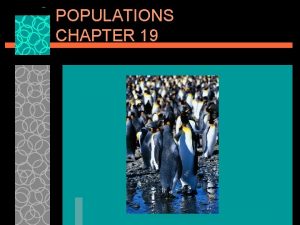43 Populations Chapter 43 Populations Key Concepts 43

























































- Slides: 57

43 Populations

Chapter 43 Populations Key Concepts • 43. 1 Populations Are Patchy in Space and Dynamic over Time • 43. 2 Births Increase and Deaths Decrease Population Size • 43. 3 Life Histories Determine Population Growth Rates • 43. 4 Populations Grow Multiplicatively, but Not for Long

Chapter 43 Populations Key Concepts • 43. 5 Extinction and Recolonization Affect Population Dynamics • 43. 6 Ecology Provides Tools for Managing Populations

Chapter 43 Opening Question How does understanding the population ecology of disease vectors help us combat infectious diseases?

Chapter 43 Opener

Concept 43. 1 Populations Are Patchy in Space and Dynamic over Time Desert landscapes tend to be a mosaic of patches of vegetation and areas of bare soil. In the Monte Desert of Argentina, seed production by grass is triggered by spring and summer rainfall. The number of seeds produced by each individual plant of the grass species Aristida mendocina increases with the amount of rainfall that occurs during summer months. Some summers are wetter than others, due to natural variation in climate. Suppose you measure the population density of this grass in a study plot before a particularly wet summer, and again some time after the summer (enough time for seeds to be shed and wind-dispersed away from the parent to germinate). Discuss what you would expect to see.

Concept 43. 1 Populations Are Patchy in Space and Dynamic over Time What will happen to the population density? a. It will stay the same because nature is “in balance” and populations always remain stable. b. It will increase within the study plot only. c. It will increase within the study plot, and areas outside the plot that were formerly bare soil may also be colonized by grasses. d. It will decline both inside and outside the plot. e. None of the above

Figure 43. 1 Species Are Patchily Distributed on Several Spatial Scales

Figure 43. 1 Species Are Patchily Distributed on Several Spatial Scales (Part 1)

Figure 43. 1 Species Are Patchily Distributed on Several Spatial Scales (Part 2)

Figure 43. 2 Population Densities Are Dynamic and Interconnected

Concept 43. 2 Births Increase and Deaths Decrease Population Size Consider the validity of the following statement: Birth and death data from one individual within a population can be extrapolated to provide birth rates and death rates for the entire population.

Concept 43. 2 Births Increase and Deaths Decrease Population Size Can birth and death data from one individual within a population be extrapolated to provide birth rates and death rates for the entire population? a. Yes, if the individual is young. b. Yes, if the individual is old. c. No, because there is individual variation in birth rates, so we have to calculate an average birth rate from a representative sample of individuals and use that to calculate per capita birth rates. d. No, because there is individual variation in death rates, so we have to calculate the average individual chance of dying from a representative sample of individuals and use that to calculate per capita death rates. e. Both c and d

Concept 43. 2 Births Increase and Deaths Decrease Population Size Which of the following factors can be used to explain a decline in the size of a population through time? • Per capita birth rates b have decreased • Per capita death rates d have increased

Concept 43. 2 Births Increase and Deaths Decrease Population Size Which of the following factors can explain a decline in the size of a population through time? a. Per capita birth rates b have decreased b. Per capita death rates d have decreased c. Per capita death rates d have increased d. Both a and c e. None of the above

Concept 43. 2 Births Increase and Deaths Decrease Population Size Change in population size depends on the number of births and deaths over a given time. “Birth–death” or BD model of population change:

Concept 43. 2 Births Increase and Deaths Decrease Population Size Population growth rate (how fast it is changing):

Concept 43. 2 Births Increase and Deaths Decrease Population Size Per capita birth rate (b)—number of offspring an average individual produces Per capita death rate (d)—average individual’s chance of dying Per capita growth rate (r) = (b – d) = average individual’s contribution to total population growth rate

Concept 43. 2 Births Increase and Deaths Decrease Population Size If b > d, then r > 0, and the population grows. If b < d, then r < 0, and the population shrinks. If b = d, then r = 0, and population size does not change.

Apply the Concept, Ch. 43, p. 845

Figure 43. 3 Life History of the Black-Legged Tick

Figure 43. 3 Life History of the Black-Legged Tick

Table 43. 1 Life Table for the 1978 Cohort of Cactus Ground Finch on Isla Daphne

Figure 43. 4 Resource Acquisition Increases with Resource Availability

Figure 43. 4 Resource Acquisition Increases with Resource Availability

Figure 43. 4 Resource Acquisition Increases with Resource Availability (Part 1)

Figure 43. 4 Resource Acquisition Increases with Resource Availability (Part 2)

Figure 43. 4 Resource Acquisition Increases with Resource Availability (Part 3)

Figure 43. 4 Resource Acquisition Increases with Resource Availability (Part 4)

Figure 43. 5 The Principle of Allocation

Figure 43. 5 The Principle of Allocation

Figure 43. 6 Climate Warming Stresses Spiny Lizards

Figure 43. 6 Climate Warming Stresses Spiny Lizards (Part 1)

Figure 43. 6 Climate Warming Stresses Spiny Lizards (Part 2)

Figure 43. 7 Environmental Conditions Affect Per Capita Growth Rates and Species Distributions

Figure 43. 7 Environmental Conditions Affect Per Capita Growth Rates and Species Distributions (Part 1)

Figure 43. 7 Environmental Conditions Affect Per Capita Growth Rates and Species Distributions (Part 2)

In-Text Art, Ch. 43, p. 850

In-Text Art, Ch. 43, p. 850

In-Text Art, Ch. 43, p. 851

In-Text Art, Ch. 43, p. 851

Concept 43. 4 Populations Grow Multiplicatively, but Not for Long r decreases as the population becomes more crowded; r is density dependent. As the population grows and becomes more crowded, birth rates tend to decrease and death rates tend to increase. When r = 0, the population size stops changing—it reaches an equilibrium size called carrying capacity, or K.

Concept 43. 5 Extinction and Recolonization Affect Population Dynamics Regional populations (metapopulations) are made up of subpopulations in habitat patches. Individuals may move in or out of subpopulations.

Concept 43. 5 Extinction and Recolonization Affect Population Dynamics The BIDE model of popultion growth adds the number of immigrants (I) and emigrants (E) to the BD growth model.

Apply the Concept, Ch. 43, p. 851

Figure 43. 8 Per Capita Growth Rate Decreases with Population Density

Figure 43. 8 Per Capita Growth Rate Decreases with Population Density (Part 1)

Figure 43. 8 Per Capita Growth Rate Decreases with Population Density (Part 2)

Figure 43. 8 Per Capita Growth Rate Decreases with Population Density

Figure 43. 9 Human Population Growth

Figure 43. 9 Human Population Growth (Part 1)

Figure 43. 9 Human Population Growth (Part 2)

Figure 43. 10 A Metapopulation Has Many Subpopulations

Apply the Concept, Ch. 43, p. 855

Figure 43. 11 Corridors Can Rescue Some Populations (Part 1)

Figure 43. 11 Corridors Can Rescue Some Populations (Part 2)

Figure 43. 12 A Corridor for Large Mammals
 Chapter 17 evolution of populations answer key
Chapter 17 evolution of populations answer key 5-1 how populations grow
5-1 how populations grow Chapter 10 comparing two populations or groups crossword
Chapter 10 comparing two populations or groups crossword Promotional concepts and strategies
Promotional concepts and strategies Lesson 1 populations answer key
Lesson 1 populations answer key Section 19-1 review understanding populations
Section 19-1 review understanding populations Population growth concept map
Population growth concept map Key business activities
Key business activities Key partners key activities key resources
Key partners key activities key resources Chapter 16 evolution of populations vocabulary review
Chapter 16 evolution of populations vocabulary review Chapter 13 how populations evolve test
Chapter 13 how populations evolve test 5-1 how populations grow
5-1 how populations grow Chapter 23 the evolution of populations
Chapter 23 the evolution of populations Chapter 16 evolution of populations
Chapter 16 evolution of populations 5.1 how populations grow
5.1 how populations grow Chapter 8 understanding populations
Chapter 8 understanding populations Chapter 23 the evolution of populations
Chapter 23 the evolution of populations Chapter 21 vulnerability and vulnerable populations
Chapter 21 vulnerability and vulnerable populations Chapter 13 how populations evolve
Chapter 13 how populations evolve Chapter 10 comparing two populations or groups
Chapter 10 comparing two populations or groups Tenets of formalism
Tenets of formalism Key concepts examples
Key concepts examples Apush period 6 key concepts
Apush period 6 key concepts Apush period 5 key concepts
Apush period 5 key concepts Period 3 key concepts apush
Period 3 key concepts apush Apush key concepts period 2
Apush key concepts period 2 Key concepts in qualitative research
Key concepts in qualitative research Key concepts of feminist therapy
Key concepts of feminist therapy Reviewing key concepts reproductive barriers
Reviewing key concepts reproductive barriers Langue vs parole in linguistics
Langue vs parole in linguistics Apush unit 2
Apush unit 2 Apush college board key concepts
Apush college board key concepts Key concepts of history
Key concepts of history Apush key concepts period 2
Apush key concepts period 2 Apush key concepts period 1
Apush key concepts period 1 Key concepts in research
Key concepts in research Basic finance concepts
Basic finance concepts Detente apush
Detente apush Unit 1: basic economic concepts answer key
Unit 1: basic economic concepts answer key What are the written codes
What are the written codes Enterprise architecture key concepts
Enterprise architecture key concepts Adlerian theory key concepts
Adlerian theory key concepts Section 4 flatworms mollusks and annelids
Section 4 flatworms mollusks and annelids Business analysis key concepts
Business analysis key concepts Deterrence and rational choice theory of crime
Deterrence and rational choice theory of crime Rational choice theory key concepts
Rational choice theory key concepts Mitochondria function
Mitochondria function Key concepts in cultural studies
Key concepts in cultural studies Operation management course outline
Operation management course outline Key concepts of diversity
Key concepts of diversity Chapter 33 entrepreneurial concepts answers
Chapter 33 entrepreneurial concepts answers Chapter 15 developing fraction concepts
Chapter 15 developing fraction concepts A survey of probability concepts
A survey of probability concepts Contrast trade promotions and consumer sales promotions
Contrast trade promotions and consumer sales promotions Chapter 1 section 3 basic concepts of democracy
Chapter 1 section 3 basic concepts of democracy Chapter p prerequisites fundamental concepts of algebra
Chapter p prerequisites fundamental concepts of algebra Chapter p prerequisites fundamental concepts of algebra
Chapter p prerequisites fundamental concepts of algebra Chapter p prerequisites fundamental concepts of algebra
Chapter p prerequisites fundamental concepts of algebra

